We are excited to welcome Dr Juan Du Plessis (M. Tech Chiro) to ScoliCare. Juan has been involved with working with Sydney Scoliosis Clinic and ScoliCare for some time now, but has only just arrived at our Sydney office to see patients in person.
Author Archive
Scoliosis Awareness Month
June is Scoliosis Awareness Month.
It’s a month focussed on uniting scoliosis patients, families, doctors, and health professionals to promote public awareness, education, and advocacy of scoliosis. The Scoliosis Research Society (SRS), the leading international spine society, is highlighting the importance of early scoliosis detection and the effectiveness of bracing as early, non-surgical care.
Case – Exercise Rehabilitation
Patient aged 18 with a left thoracolumbar curve measured at 39 degrees and a thoracic compensatory curve.
Background
Patient presented to the Sydney Scoliosis Clinic aged 18 at the time of initial examination. The patient had been diagnosed with scoliosis at 16 years of age, after reporting back pain and noting some postural issues (asymmetry of the waist and hips).
She was diagnosed with a left thoracolumbar curve measured at 39 degrees with a thoracic compensatory curve.
The patient had previously seen an Osteopath and Chiropractor for the pain but couldn’t seem to get relief. Her pain averaged a 6-7/10 and 9/10 at its worst. Playing sport and standing for long periods made the pain worse.
In the two years since diagnosis, the scoliosis had progressed 10 degrees. It was unlikely that the curve would progress any further with minimal growth expected due to her age.
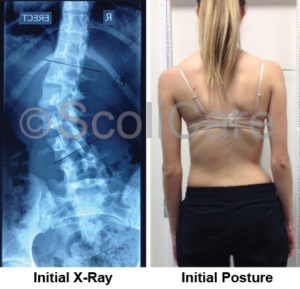
Treatment
6 scoliosis specific rehabilitation sessions based on the SEAS approach were intitally prescribed to help stabilise the curve and decrease pain. The self-correction prescribed to the patient was specific to her scoliosis and other exercises were prescribed to increase core and lower back strength and stability.
The treatment also included the use of a scoliosis treatment aid, namely a tractioning device that the patient could use at home. She spent approximately 40mins a day at home doing the specific exercises and using the orthotic, and 1 hour a week with the Exercise Physiologist.
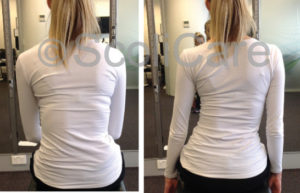
Results
After 4 weeks of treatment, the patient’s back pain had decreased to minimal if any, and her body had adapted to the self-correction and scoliosis orthotic allowing her to improve the range of movement of her spine.
By the 6th week, there were noticeable changes to her relaxed posture and the waist and hips were now more symmetrical. Her muscular endurance tests showed that she had improved by over 1min in both abdominals and trunk extensors over the 6 weeks. At this point the patient’s back pain averaged 0/10 most of the time and 2-3/10 occasionally when leaning over her desk studying.
The patient felt that the exercises had helped reduce the pain and her back felt a lot stronger. She also noted that lying on the orthotic helped her get relief when she was in pain.
After 4 months of treatment, an x-ray was taken and the curve had reduced from the initial 39 degrees to 29 degrees.
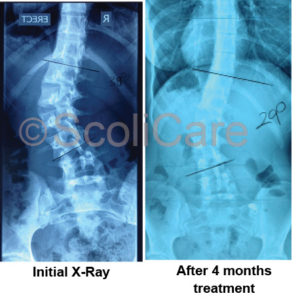
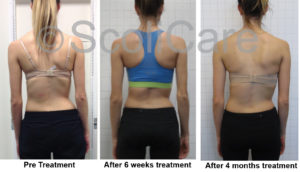
Conclusion
The patient now attends the clinic regularly to review exercises and assess her progress. The duration of the exercises is now approximately 10mins a day, 7 days a week to make it more manageable for the patient long-term.
Since starting the exercises program, the patient’s ability to maintain her self-correction has greatly improved and she is challenged with more advanced exercises each time she comes in for review. She is very pleased with her results, particularly the improvement in the hip asymmetry and the reduction of her pain.
NB: Results vary from case to case. Our commitment is to recommend the most appropriate treatment based on the patient’s type and severity of scoliosis.
© ScoliCare 2015
Case – Bracing and Exercise Rehabilitation
Male patient aged 14 years with a right thoracic curve measured at 49 degrees.
Background
This patient was diagnosed with Scoliosis by his Physiotherapist at the age of 13 years old with a curve of 39 degrees. They first consulted a surgeon about the case who suggested surgery or bracing.
A year later they presented to the Sydney Scoliosis Clinic for bracing and the curve had progressed a further 10 degrees. The patient was not experiencing any pain from the scoliosis, but did notice the asymmetrical shape of his torso. This patient is a National medallist in Athletics and also previously played representative Australian Rules Football. Due to his regular training, this patient had a good general strength and flexibility.
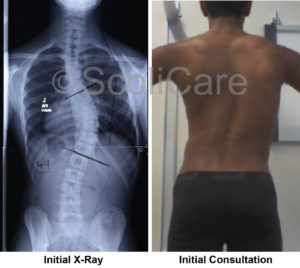
Treatment
This patient’s treatment involved wearing a customised rigid brace for 23 hrs per day, ongoing scoliosis specific exercise sessions and tractioning exercises with a scoliosis treatment aid. His brace wear started at 2 hrs per day, which was built up gradually over the following weeks to 23 hours each day. The patient does not compete in the brace but is very diligent in putting it back on straight after an event.
The scoliosis specific exercises require him to position his body in an active self-correction, which is the mirror image of his scoliosis, and to also work on strengthening his core and lower back muscles with exercises specifically prescribed for his case. He regularly sees the exercise physiologist to assess his progress and increase the difficulty of the exercises to ensure he keeps improving.
The patient does quite advanced exercises and we have now started incorporating his active self-correction to warm-up movements he does at training to help keep his spine in good alignment when he is out of the brace. The home exercises are done every day and take approximately 40mins to complete.
Results
From examining xrays and posture photos, there has been an improvement in this patient’s posture in the first 12 months of treatment. The intial curve of 49 degrees, has now decreased to 35 degrees.

Due to his age and currently being Risser 4, it is essential for the brace treatment to continue while he is still growing. If left untreated, the scoliosis can progress further with growth.
At the beginning of the treatment, the patient was not competing at his best, but after a period of adaptation and the inclusion of specific exercises, he is now excelling and is back to the optimal form he was in prior to starting his scoliosis treatment.
The patient and his family are very committed to his treatment and to helping him succeed.

Conclusion
This case demonstrates the reduction of a large curve that was at a surgical level to a moderate curve no longer at risk of needing surgery. The combination of a rigid custom designed 3D scoliosis brace, with scoliosis specific exercise, may achieve reduction in curve and cosmetic improvement in similar cases.
The patient was also able to continue competing at an elite level without compromising his ability.
NB: All cases are different and results may vary case to case. Our commitment is to recommend the most appropriate treatment based on the patient’s type and severity of scoliosis.
© ScoliCare 2015
Case – Kyphosis Bracing
Patient aged 16 years with Kyphosis measured at 61 degrees.
Background
Patient presented to the Melbourne Scoliosis Clinic aged 16 years at the time of initial examination complaining of a sore back and poor posture. He was diagnosed with a Scheuermann’s kyphosis measuring 61 degrees.
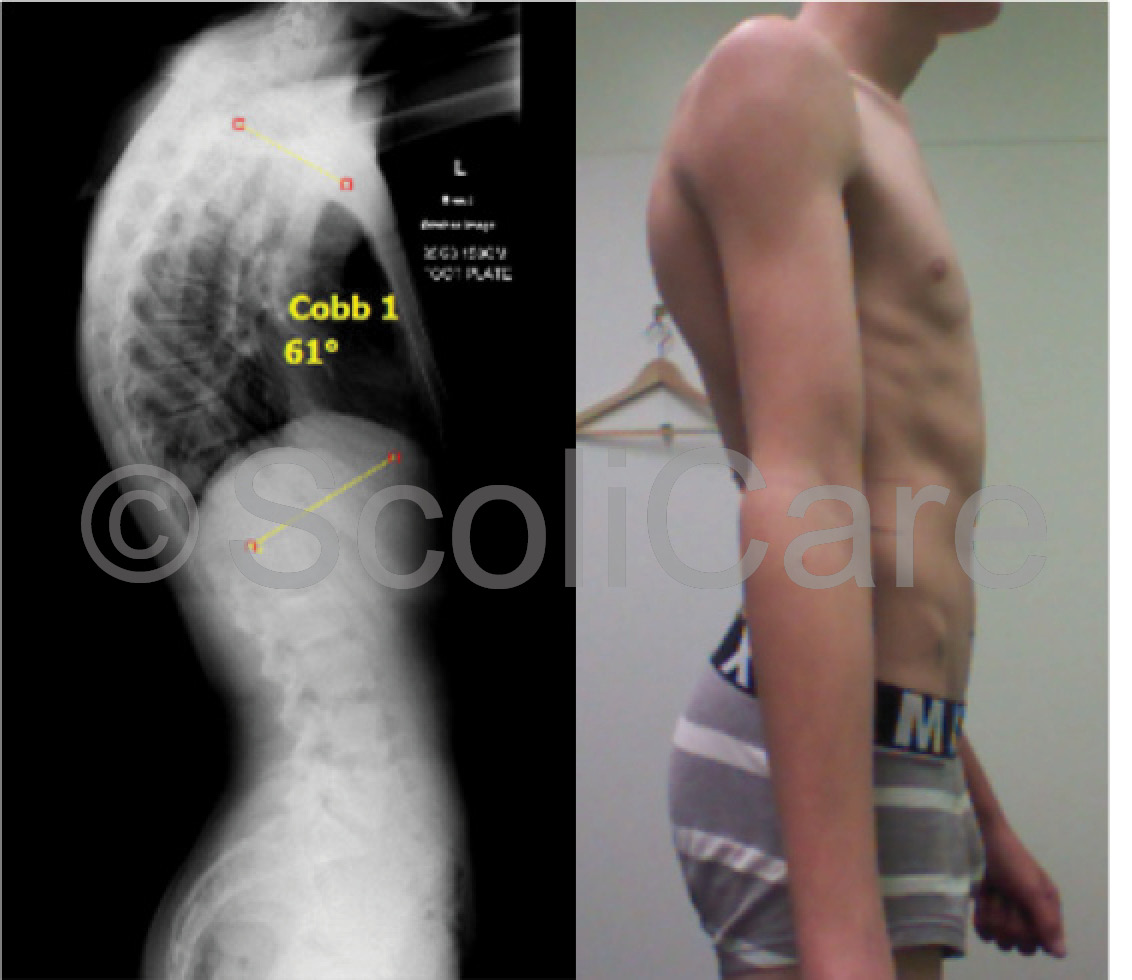
Treatment
A custom 3D designed kyphosis brace was recommended to help reduce and stabilize the kyphosis. This brace was created specifically for this patient through a specialised 3D scanning and manufacturing process.
It was recommended that this Kyphosis brace be worn for 20 hours per day for a 24 month period. The brace was very low profile and with clothes over the top was nearly impossible to see.
Results
At the 3 month mark, an in-brace x-ray was taken. The in-brace kyphosis had reduced to 47 degrees.The patient’s posture was also improved.
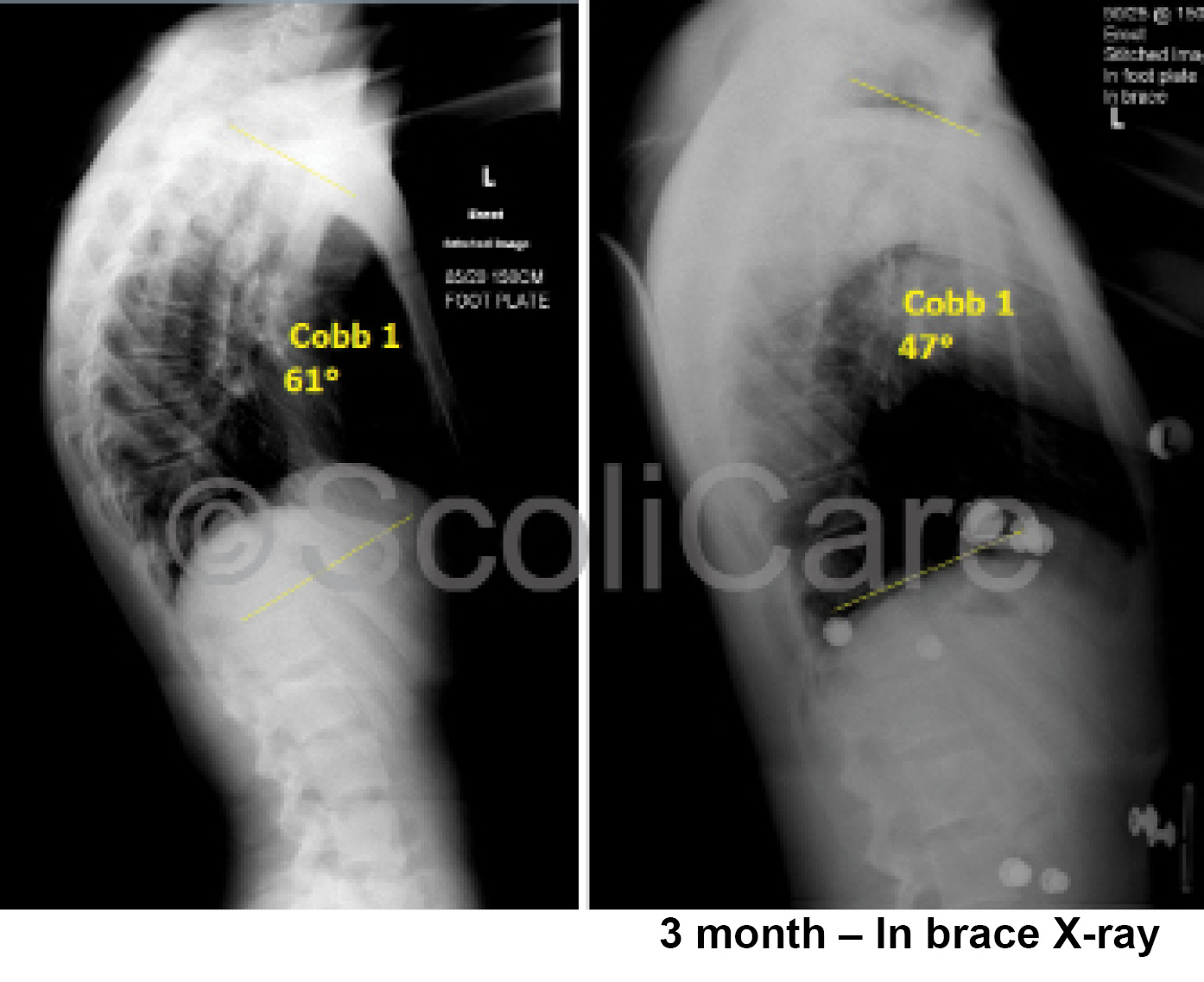
After 4 months of treatment, an out of brace x-ray was taken. The Kyphosis had reduced from 61 to 48 degrees.
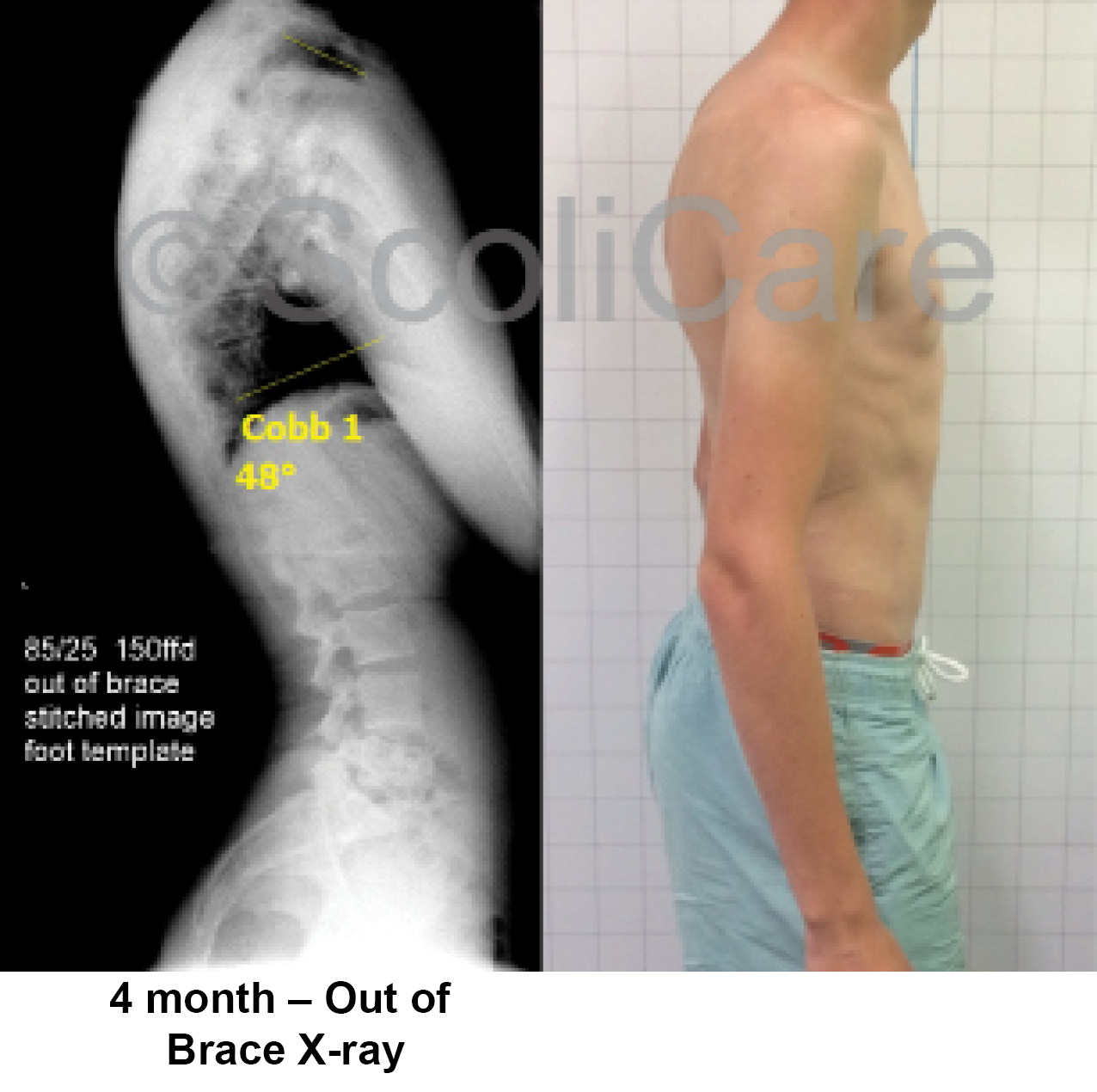
Discussion
Scheuermann’s kyphosis is a progressive spinal deformity that can worsen with growth and if it gets too severe requires surgery. Bracing is recommended when a Kyphosis progresses beyond 60 degrees as there is a tendency for the curve to continue to worsen even after growth has finished. Surgery is often recommended if the curve is greater than 70 degrees.
Old fashion braces used to be the only way to non-surgically treat kyphosis. The development of specialised kyphosis braces however, means there is now another bracing treatment option for kyphosis in teens and young adults that aims to not only hold but also reduce the kyphosis and is low profile and hardly visible under clothing.
Conclusion
In this case, xrays showed both improvements in the patient’s postural appearance, and the degree of the curve. A rigid custom designed 3D kyphosis brace may achieve reduction in kyphosis curve in similar cases of Scheuermann’s kyphosis.

NB: All cases are different and results may vary case to case. Our commitment is to recommend the most appropriate treatment based on the patient’s severity of kyphosis
© 2015 Scolicare
Case – Bracing and Exercise Rehabilitation
Patient aged 17 with scoliosis curve measured 44 degrees reduced to 29 degrees.
Background:
Patient presented to the Sydney Scoliosis Clinic aged 17 at the time of initial examination. Adolescent Idiopathic Scoliosis was diagnosed 18 months earlier and no treatment was undertaken during this time. At the initial consultation the scoliosis curve measured 44 degrees. This patient had seen a surgeon and was recommended to undergo surgery. She reported having bad back pain (7-8/10) most days. The pain was worse after dance classes.
The patient was on track to become a professional ballet dancer however the pain and the effect of the scoliosis on the body posture and the effect that surgery would have on the spinal flexibility meant that this future career was at risk.
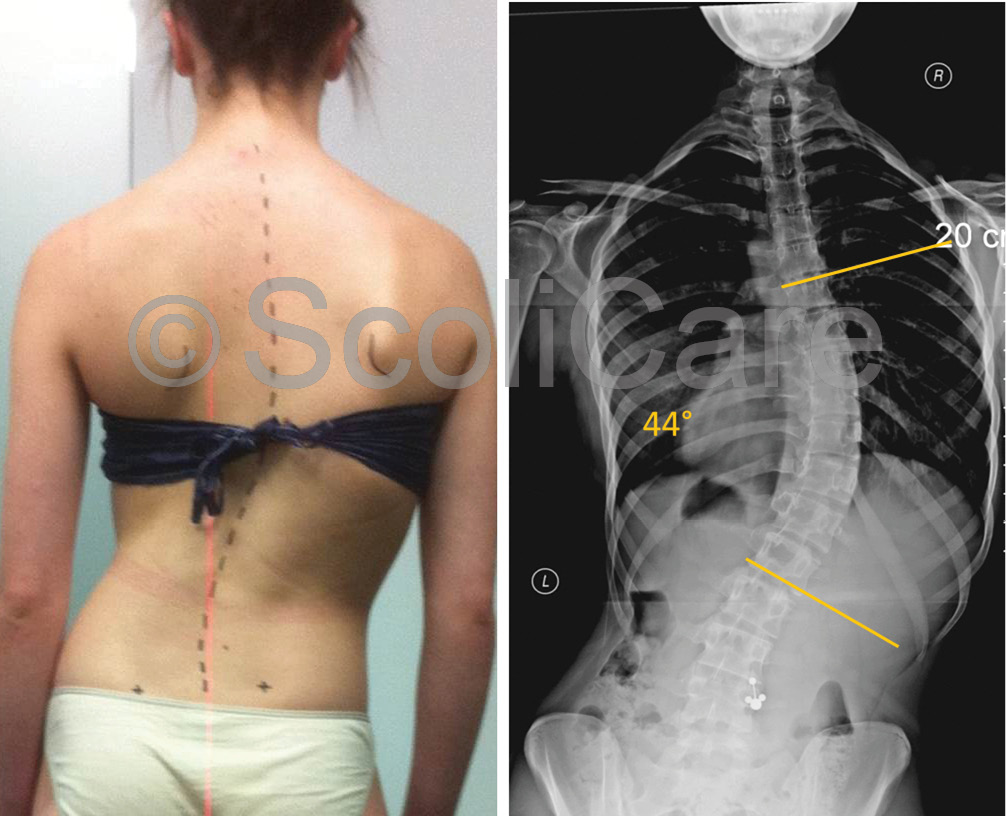
Treatment:
A combination of customised 3D designed rigid brace wear, and a scoliosis specific exercise program based on the SEAS principles was recommended. It was recommended to use the brace for 6-8 hours per day and to do the exercises twice per day for 20 minutes. This intensive regime was recommended for 3-6 months.
Results:
As seem from x-rays and posture photos, a cosmetic improvement in the body was seen within the first 4 weeks. This improvement was maximised at 6 months. After the end of intensive treatment, the body posture settled to its new corrected position which is demonstrated at the 12 months photo. At the 12 month mark an x-ray was taken with an independent radiology clinic with the patient standing in her relaxed normal posture. This shows an improvement in the scoliosis curve and the alignment of the spine. The curve was corrected by 15 degrees, reducing from 44 degrees to 29 degrees.
The patient’s pain was reduced to 2-3/10 and was only present on an occasional basis. As the body posture improved so did the performance at ballet. At the end of the intensive part of the treatment program the patient was selected to join a top ballet institution overseas. As a result of these improvements surgery was cancelled.
Discussion:
This case demonstrates the potential for a combination of customised 3D designed rigid brace wear and scoliosis specific exercise to improve the cosmetic look of the body, the spinal alignment and degree of curve, and the pain associated with the scoliosis. Although relatively mature this patient was able to achieve 15 degrees of correction of her curve.
Although this may not be achievable in every case it shows that in cases where the patient is flexible and there is an aspect of the scoliosis that is not fixed it may be possible to make correction even after growth has finished. Continuation of the exercise program may be required to maintain the correction.
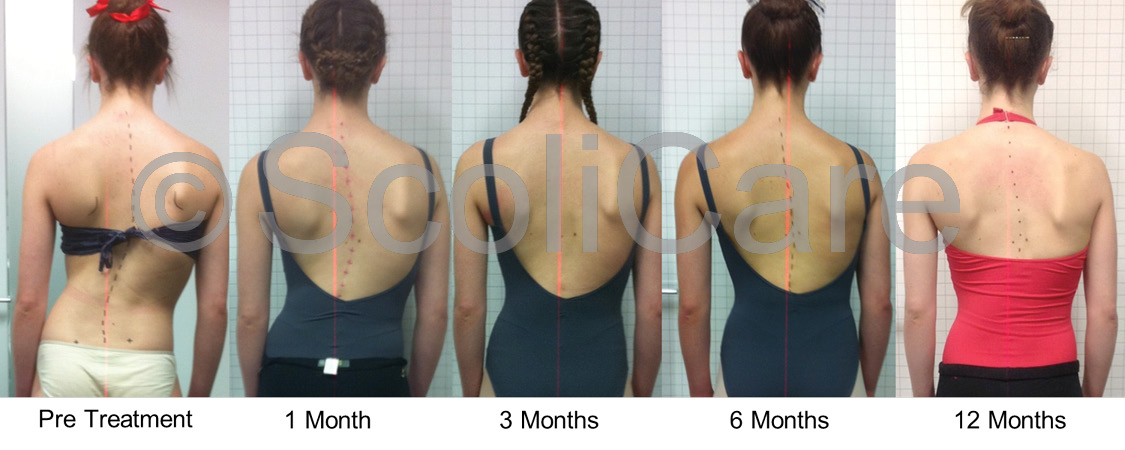
Conclusion:
In this case it was possible to reduce a large curve that was at a surgical level to a moderate curve no longer in need of surgery. Choosing the right treatment to achieve the goals of cosmetic improvement, curve reduction, and pain relief was successful in this case.
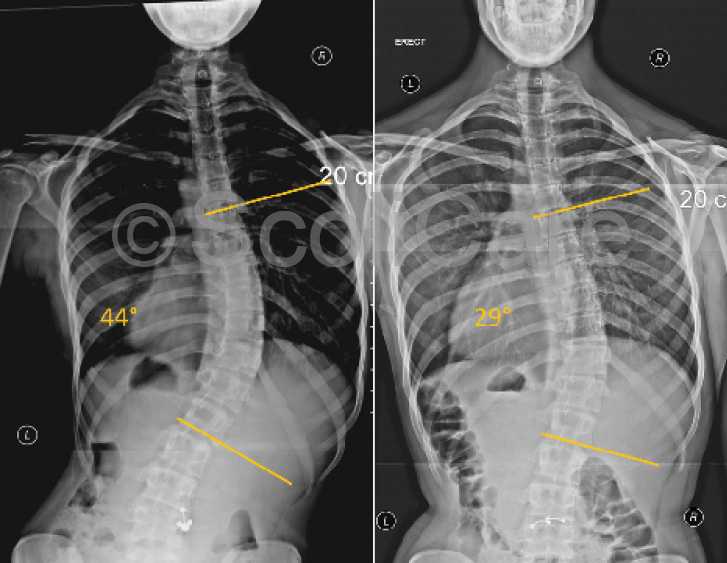
NB: All cases are different and results may vary case to case. Our commitment is to recommend the most appropriate treatment based on the patient’s type and severity of scoliosis.
© ScoliCare 2015
Case – Bracing and Exercise Rehabilitation
Patient aged 13 with scoliosis curve measured 44° in the thoracic spine and 43° in the lumbar spine reduced to 35° and 15° in 8 months!
Background:
Patient presented to the Sydney Scoliosis Clinic aged 13 at the time of initial examination. Postural issues had been noticed 6 months earlier. At the initial consultation the scoliosis curve measured 44° in the thoracic spine and 43° in the lumbar spine. Her pelvic growth plates were open and graded as Risser stage 1. Adolescent Idiopathic Scoliosis was diagnosed. This patient had been recommended to undergo surgery.

Treatment:
A combination of full time bracing using a customised 3D designed rigid brace and a daily home rehabilitation program, using a scoliosis treatment aid and Mirror Image exercises, was recommended. It was recommended to wear the brace for 23 hours per day and to use the treatment aid once per day for 20 minutes. This treatment regime was recommended for a minimum 24 months as the patient was immature and had substantial growth remaining.
Results:
As can be seen from the photos, a cosmetic improvement in the body was seen within the first 3 months. This improvement was maintained at 12 and 18 months. At the 3 month mark an in-brace x-ray was taken showing very good correction of the curve. The thoracic curve reduced from 44 to 20 degrees and the lumbar curve reduced from 43 to 14 degrees (in the brace).
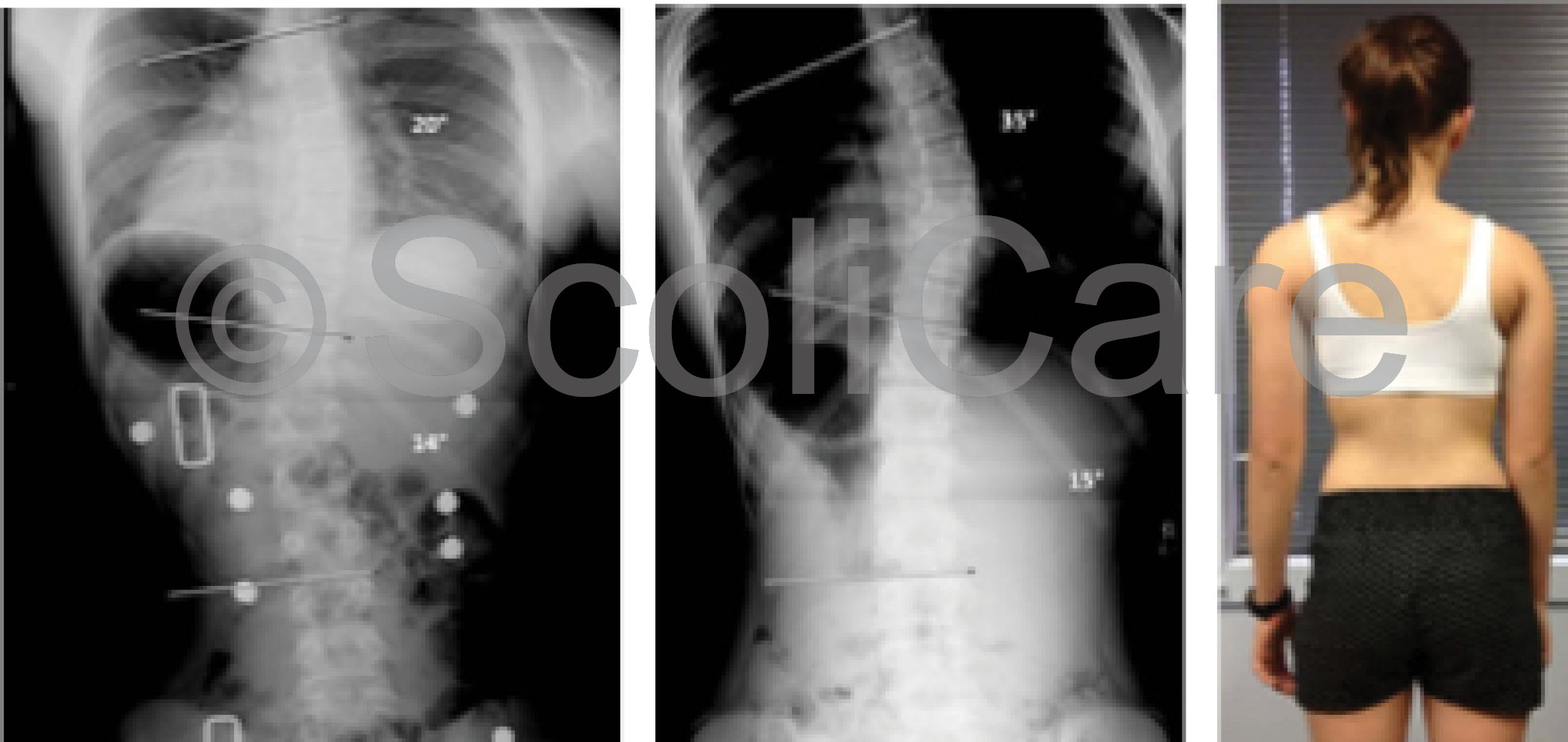
At the 8 month mark an out-of-brace x-ray was taken at an independent radiology clinic, with the patient standing in her relaxed normal posture. This showed a significant improvement in the scoliosis curves. The lumbar curve was corrected by a staggering 28 degrees!
The thoracic spine curve was corrected by 9°.
The patient has continued with compliant treatment, and postural photographs at the 12 and 18 month mark show stability of the result. She is continuing with treatment.
Discussion:
Xrays and posture photos from this case have shown that this combination of treatment has been able to improve the cosmetic look of the body, the spinal alignment and the degree of curve. Although still immature and undergoing treatment, this case represents a positive initial result that will likely result in this patient avoiding spinal fusion surgery in the future.
Conclusion:
A rigid custom designed 3D scoliosis brace, in combination with a scoliosis specific exercise program, may achieve reduction in Cobb angle in similar cases. Choosing the right treatment with the aim of curve reduction and cosmetic improvement, are so far proving to be successful in this case.

NB: Results vary from case to case. Our commitment is to recommend the most appropriate treatment based on the patient’s type and severity of scoliosis.
© ScoliCare 2015
Case – Bracing
Patient aged 7 years with scoliosis thoracic curve measured at 32 degrees and lumbar curve measured at 27 degrees.
Background
Patient presented to the Sydney Scoliosis Clinic, aged 7 years at the time on initial examination. This patient had been recommended and fitted with a traditional 3 point pressure hospital made TLSO.
This brace had achieved minimal in-brace correction – the thoracic curve had been reduced from 32 to 21 degrees. The lumbar curve remained the same in brace.
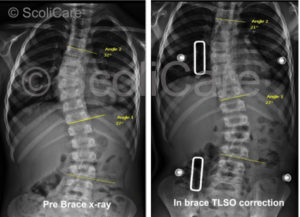
Treatment
The patient was recommended a customised 3D designed rigid brace. New in-brace x-rays show an improved in-brace correction in this brace compared to the hospital TLSO.
Results
Thoracic curve reduced to 13 degrees which was a correction of 19 degrees and 8 degrees better than the hospital brace. The lumbar curve reduced to 3 degrees which was a correction of 24 degrees. The hospital brace made NO improvement in the lumbar curve.
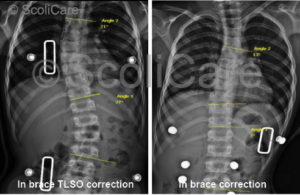
Discussion
The customised rigid brace created for this patient was not a traditional 3 point pressure brace. Instead the brace used a concept of spinal repositioning by over correcting the body posture and using specific 3D moulding to main the correction in the brace. As highlighted in Stokes review on bracing published in Bone Joint Journal. 2013 titled “The current status of bracing for patients with adolescent idiopathic scoliosis”. Stokes states that; “In conclusion…The Hueter–Volkmann principle holds true for bracing in AIS. If a brace does not correct a curve onapplication, then either the brace has not been designed, manufactured or fitted correctly, or the curve cannot be braced.”
This case demonstrates a clear difference in corrective effect on the same patient by two different braces. One of the braces had poor correction and most likely would have not stopped progression of the curve. The other had good correction and has a much high chance of stopping progression or improving the curve.
Conclusion
Not all braces are the same. In this case the 3D designed, customised rigid brace clearly showed a superior in-brace correction to the hospital manufactured brace for the same patient. Although this case has not reached its end point and treatment is ongoing, this case shows a rigid custom designed 3D scoliosis brace may achieve reduction in Cobb angle in similar cases.
NB: All cases are different and results may vary case to case. Our commitment is to recommend the most appropriate treatment based on the patient’s type and severity of scoliosis.
© ScoliCare 2015
Interview with Dr McAviney – The Australian Chiropractor
Did you see the recent interview with Dr McAviney in the November Australian Chiropractor magazine?
It’s a great piece looking into Dr McAviney’s research background and the links with scoliosis; exploring why co-management of scoliosis patient’s care is so important; and discussing the upcoming Sydney Spine Symposium, an event designed for Chiropractors and other Health Professionals to attend.
Read the article here
New Study Backs Bracing For Treating Scoliosis
The 28th of June is earmarked as “International Scoliosis Awareness Day”. It’s an important initiative and great opportunity to educate Australians, and the rest of the world, about one of the least understood spinal development conditions, Scoliosis.
As we all know, Scoliosis is commonly detected during adolescence and can cause spinal deformity, posture imbalance, and in severe cases it can affect the function of the heart and lungs. Various evidenced treatment options have been shown to be effective depending on the stage and severity of the scoliosis curve – options include special scoliosis exercise therapies, rigid or dynamic bracing, and in advanced stages, surgery.